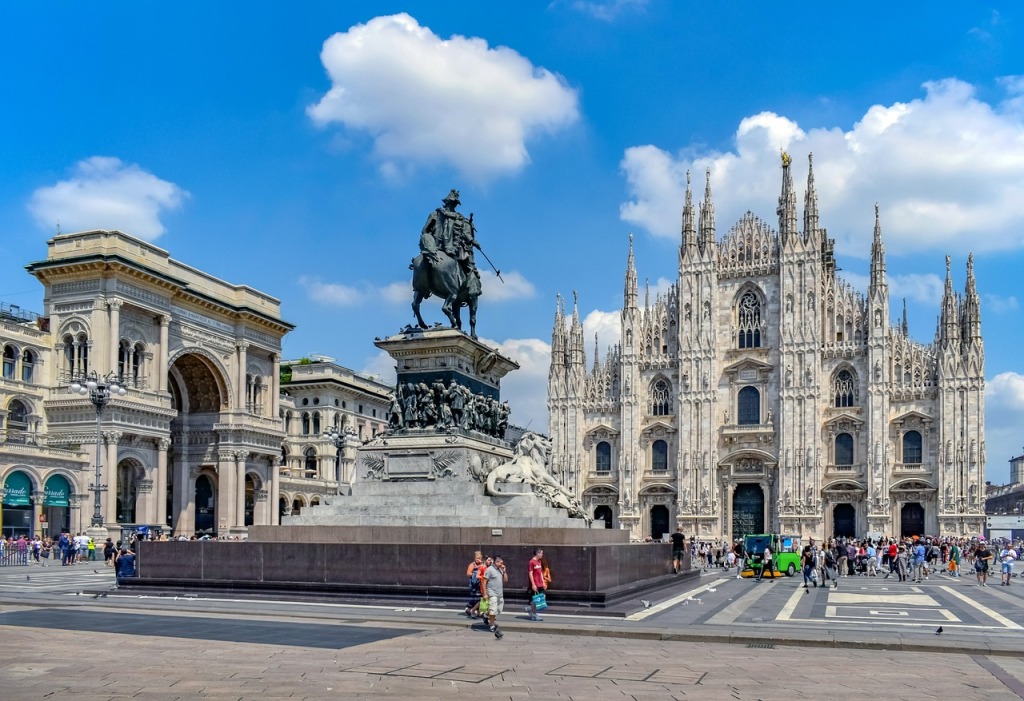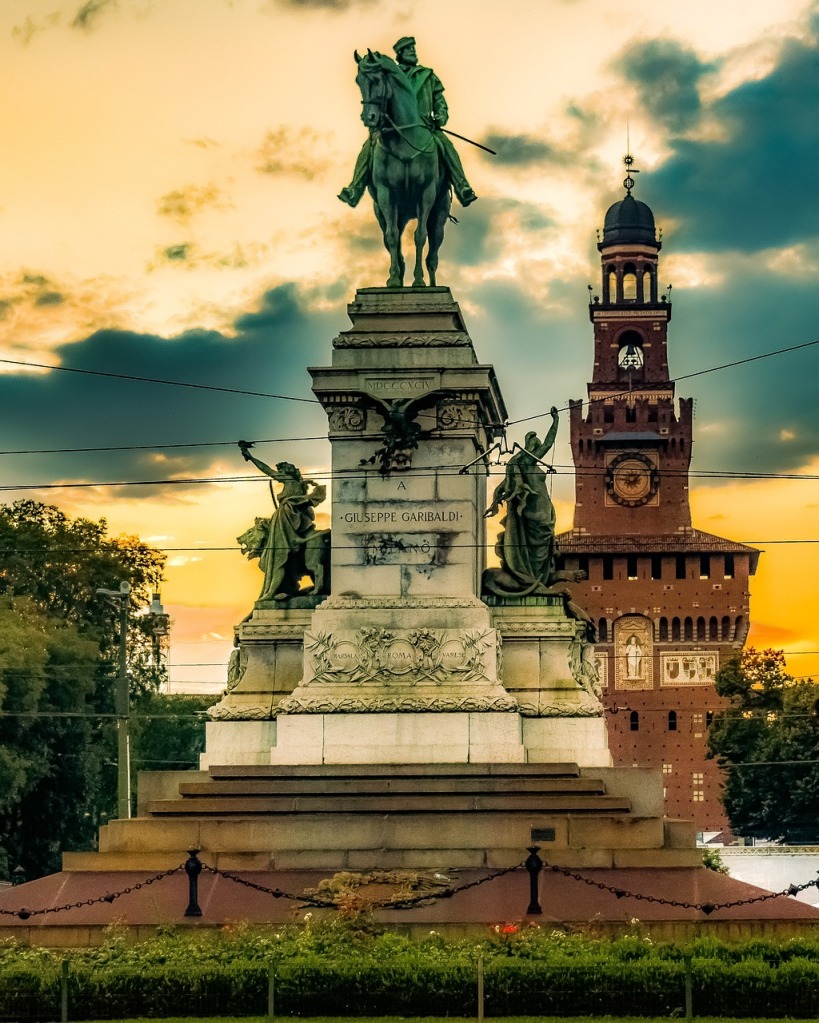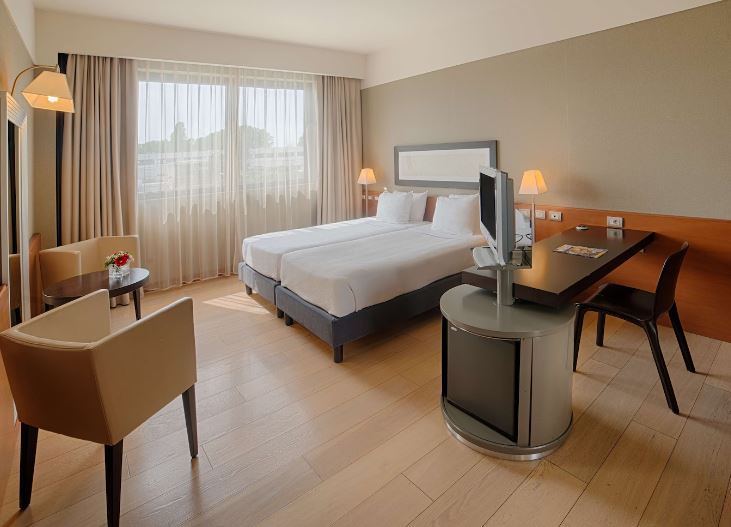Way to make a Travel > Travel stories > Fashion Capital
MILAN, ITALY – For every church in Rome, there’s a bank in Milan. Italy’s second city and the capital of Lombardy, Milan is a hard-working, fashion-conscious city where time is money, with 1.5 million inhabitants. Milan is fashion capital and a melting pot of people and history. Its industriousness may stem from the Teutonic blood of its first inhabitants, the Lombards, or from the region’s Austrian heritage. Milan is Italy’s industrial, banking, television, publishing and fashion capital. Modern Italy’s economic success can be attributed to this city of advertising and delicious lunches.
Milan is an international fashion capital with a refined taste. Window displays are gorgeous, cigarettes are chick and even the cheese comes gift-wrapped. Yet luckily, Milan is no more expensive for tourists than other Italian cities. Many tourists come to Milan for the past. While is not big on the tourist circuit, Milan has plenty to see.

History of Milan
The Romans called this place Mediolanum, or ‘the central square’, three hundred years before Christ. By the 4th century AD it had become the capital of the Western Roman Empire. From there, Emperor Constantine proclaimed the Edict of Milan, legalizing Christianity. After a period of barbaric gloom, Milan became an important city in the Middle Ages under the rule of the Visconti and Sforza. During the Renaissance it was known as ‘New Athens’ and served as a cultural center for Leonardo da Vinci. Then came 400 years of foreign rule (Spain, Austria and France). Milan was one of the centers of the 1848 uprising against Austria and contributed to the unification of Italy in 1870.
Milan is an international fashion capital with a refined taste. Window displays are gorgeous, cigarettes are chick and even the cheese comes gift-wrapped. Yet luckily, Milan is no more expensive for tourists than other Italian cities. Many tourists come to Milan for the past. While is not big on the tourist circuit, Milan has plenty to see. Musolini left a heavy fascist touch on the city architecture. His excesses also lead to the WWII bombing of Milan. But Milan rose again. The 1959 Pirelli Tower was a trendsetter in its day.
Many tourists come to Italy for the past. But Milan is today’s Italy, and no Italian trip is complete witohout visiting it. While it’s not big on the tourist circuit, Milan has plenty to see. And fortunately, seeing Milan manageable and well-organized is not difficult.
Getting to and around Milan
Most international flights land at the manageable Malpensa Airport, 28 miles northwest of Milan. You have three easy ways to get to downtown Milan: by train, shuttle bus or taxi. The Malpensa Express train zips between Malpensa airport and Milan’s Cadorna station, which is both a Metro stop and a small train station, closer to Duomo than the central train station. Two companies run buses between Malpensa airport and Milan’s central train station. The buses are virtually identical in everything except price, using the same departure points in front of the airport and from Piazza Luigi di Savoia at the east side of the train station.
Getting to Milan by train is possible from Venice, Florence, Genoa, Rome, Brindisi, Cinque Terre, Varenna on Lake Como and Stresa on every hour respectively.
Use Milan’s great subway system. The clean, spacious, fast and easy three-line Metro zips you nearly anywhere you may want to go, and trams and city buses fill in the gaps. The handiest Metro line for a quick visit is the yellow line 3, connecting the train station to the Duomo. A ticket valid for 75 minutes, can be used for one subway, tram, or bus ride, plus a transfer.

Milan sightseeings

Duomo Cathedral
The city’s centerpiece is the fourth largest church in Europe, after the Vatican’s, London’s and Seville’s. Back when Europe was fragmented into countless tiny kingdoms and dukedoms, the dukes of Milan wanted to impress their counterparts in Germany and France. Their goal was to earn Milan recognition and respect from both the Vatican and the kings and princes of Northern Europe by building a massive, richly ornamented cathedral. Even after Renaissance domes were in vogue elsewhere in Italy, Milan’s cathedral stayed on Gothic target. The dukes loaded it with pointed arches and spires. For good measure, the cathedral was built not of ordinary stone but of marble from top to bottom, rafted across Lake Maggiore from a quarry about 50 miles away to a canal port at the cathedral.
While visiting from inside two tiny lights can be seen at the back rear wall. The little red one above the altar marks where a nail from the cross of Jesus is kept. This relic was brought to Milan by St. Helen in the 4th century, when Milan was the capital of the Western Roman Empire. It’s on display for three days a year. High to the right is where a tiny pinhole of white light is located. This is designed to shine a 10-inch sunbeam onto the bronze line running across the floor at noon, indicating where we are on the zodiac. Deeper into the church up the right aisle are where the 15th century colored glass mosaic windows are placed. Brilliant and expensive these windows were bought by wealthy families seeking the Church’s favor. Many of the left date from the time of Napoleon and are dimmer, cheaper painted glass. While the church is Gothic, the altar was made Baroque in the style of Vatican XVI century style. The treasury to the right under the altar thrills pilgrims with reliquaries containing thorns from Jesus crown and ”Tree of Apostles” with bones, fingernails and hair from each of the 12 apostles. Milan was an important center of the early Christian Church. In Roman times, Mediolanum’s street level was 10 feet below today’s level. In the rear of the church climbing down, (admission applies) you can see the scant remains of an eight-sided Baptistery and a little church. Back then, since you couldn’t enter the church until you were baptized, which didn’t happen until the age of 18, churches had a little ”holy zone” just outside for the unbaptized. This included a Baptistery.
The Cathedral rooftop is the most unforgettable aspect of a Duomo visit. You’ll walk through a magnificent forest of spires with spectacular views over the city, the square, and, on clear days, the Swiss Alps. This 15-foot-tall gilded Virgin Mary serves as the city’s symbol.
Duomo Museum
To really understand Milan’s cathedral and enjoy a chance to see its original art close up, visit the cathedral museum and enjoy its original art close up. In all of it’s 20 rooms you’ll see unique exhibits such old expressive marble statues, Byzantine-style crucifix, tapestries, huge paintings, terra-cottas and more.

Bus Tours
The three hour Autostradale city bus tour is a good value, has a live guide, and guarantees you’ll see Leonardo’s Last Supper. The two different itineraries also include visit to the Duomo, Galleria, Sforza Castle and possibly La Scala Opera House.
Piazza Duomo
Milan’s main square Piazza Duomo is a classic European scene and a popular local gathering point. The Duomo area is thick with people-watching, reasonable eateries, and the major sightseeing attractions. From the central train station to the Duomo, it’s just four stops on a direct Metro lineto Metro: Duomo. Standing in the square you’re surrounded by history. The statue is Victor Emmanuel II, first king of Italy. He’s looking at the grand Galleria named for him. The words above th entrance read: ”To Victor Emmanuel II, from the people of Milan”. Behind the statue is the center of Piazza mercanti .
The medieval city hall, dating from 1220, marked the center of town back when the entire city stood within its immense fortified walls. The merchant’s square is a strangely peaceful place today, with a fine smattering of old-time Milano architecture.
Opposite the Galleria are twin fascist buildings, Mussolini made grandiose speeches from these balconies. Study its relief panels telling the history of Milan. Between these buildings and the cathedral is the historic Ducal Palace, Palazzo Reale. The Duomo center is a modern mall with a Virgin Megastore, one-hour photo service, Spizzico pizzeria, and Ciao cafeteria. Behind the Duomo is a vibrant pedestrian shopping zone along Corso Vittorio Emanuele.
Galleria Vitorio Emanuelle
A symbol of this beautiful fashion capital is its great four-story, glass-domed arcade on the cathedral square. Here you can turn an expensive cup of coffee into a good value by enjoying Europe’s best people-watching.
The venerable Bar Zucca, with a friendly staff and Art deco interior typical of the 1920s, is the former haunt of famous opera composers Giuseppe Verdi and Arturo Toscanini, who used to stop by after their performance at La Scala. It’s a fine place to enjoy a drink and people -watch. Once called the Campari cafe, this is considered the birthplace of the famous Campari bitter.
Wander around the gallery. Its art celebrates the establishment of Italy as an independent country. Around the central dome, patriotic mosaics symbolize the four major continents.



Vitorio Emanuelle Gallery by Alex
The mosaic floor is also patriotic. The white cross in the center represents the king. The she-wolf with Romulus and Remus honours the city that, since 1870, has been thenational capital. On the west side, you’ll find that city’s symbol, a torino means little bull. For good luck, locals step on his little testicles.
La Scala Opera House and Museum
From the Galleria you’ll see a statue of Leonardo. He’s looking at a plain but famous neoclassical building, possibly the world’s most prestigious opera house, Milan’s Teatrale alla Scala. La Scala opened in 1778 with an opera by Antonio Salieri. Milan’s famous opera house and its adjacent museum have just reopened after a lengthy restoration. Opera buffs can see the museum’s extensive collection, and probably sneak a peak of the theater. The collection features things like Verdi’s top hat, Rossini’s eyeglasses, Toscanini’s baton, Fettuccine’s pesto and original scores, diorama stage sets, costumes, busts, portraits, and death masks of great composers and musicians.
Brera Art Gallery
Milan’s top collection of Italian paintings from the early 13th to the late 20th century, is world-class art gallery. Established in 1809 to house Napoleon’s looted art, it fills the first floor above an art college. The gallery’s highlights include works by Gentile da Fabriano, the Bellini brothers and Mantegna, Crivelli, Raphael’s Wedding of the Madonna, Piero Della Francesca’s Madonna and Child with Four Angels and Michelangelo Merisi.


Sforza Castle
The castle of Milan tells the story of the city in brick. Built in the late 1300’s as a military fortress, it guarded the gate to the city wall and defended the city from enemies. It was beefed up by the Sforza duke in 1450 in anticipation of a Venetian attack. Later, it was the Renaissance palace of the Sforza family and was even home to their in-house genius, Leonardo. During the centuries of foreign rule, it was a barracks for occupying soldiers. Today, it houses several museums.
Santa Maria delle Grazie Church
Appointments are required to see Leonardo da Vinci’s The Last Supper, a Renaissance masterpiece on display in the Cathedral of Santa Maria delle Grazie. To reduce humidity, 25 tourists are admitted every 15 minutes for a tour that lasts exactly 15 minutes. For your appointment, you wait in different rooms while doors close behind you and gradually open in front of you. If you’re traveling during peak season, make reservations at least three days in advance for weekday tours and one week in advance for weekend stays.
Because of Leonardo’s experimental fresco technique, deterioration began within six years of its completition. The 21-year restoration project was completed in 1999 and peeled 500 years of touch-ups away, leaving a faint but vibrant masterpiece.
Milan World-class shopping
The ”Quadrilateral” an elegant high-fashion district around Via Montenapoleone, is fun for shoppers. Most places close Sunday and for much of August. On Mondays, stores open only after 16:00. In this land where fur is still prized, the people-watching is an entertaining as the window-shopping. Via Montenapoleone and the pedestrianized Via Spiga are the best streets. From La Scala, walk up Via Manzoni to the Metro shop at Montenapoleone, browse down Montenapoleone to Piazza San Babila, then walk down the pedestrian only Corso Vittorio Emanuele to the Duomo.



Milan is people-friendly city with a great transit system and inviting pedestrian zones.
Cafes, Bars and Restaurants in Milan
This is a fast-food city, but fast-food in a fashion capital isn’t a burger and fries. The bars, delis, rosticcerie, and self-service cafeterias cater to people with plenty of taste and more money than time. You’ll find delightful eateries all over the town. To eat mediocre food on a famous street with freat people-watching, choose an eatery on the pedestrian-only Via Mercanti or Via Dante. To eat with students in trendy little trattorias, explore the Brera neighborhood. To eat well near Duomo, consider the recommended places of Trattoria Milanese, Restroante als Mercante or La Rinascente.
Milan specialties
Milan’s signature dishes are risotto alla Milanese and ossobuco. The risotto is flavored with saffron, which gives it its intense yellow color. It’s said that A 16-th century Belgian glassworker first stumbled on the use of saffron as a spice. Initially, he used saffron to tint the glass mixture he used to complete the stained-glass windows of the Duomo in 1574. His master joked that he’d end up adding the precious spice to his food as well. On the day of his master’s daughter’s wedding, the glassworker persuaded the chief to add saffron to the rice cooked for the reception. After the guests got over their initial surprise, the dish was a great success, and has been a staple on Milan’s menus ever since.


Locals like to precede a lunch or dinner with an aperitivo Camparior any Italian champagne. Bars fill their counters with inviting baskets of munchies, which are served free with these drinks. A cheap drink can become a light meal.
Places to eat in Milan
Ristorante al Mercante is the place to dine elegantly inside or outside under historic arches in a peaceful square a block from the cathedral. It’s pretty touristy, and you’ll pay extra for the location, but the food is very good. Make a meal out of their extensive antipasto buffet featuring fresh sliced prosciutto, mozzarella di buffalo, grilled and marinated vegetables and more.
Pizzeria Ristorante al 50 da Geggio is a friendly and bustling little favorite packed with locals eating delicious Tuscan food under fans.
The seventh floor of the big department store La Rinascente, alongside the Duomo, has three rooftop eateries, each with a terrace overlooking the ornate top of the cathedral.
Bistrot is a dressy restaurant serving modern Mediterranean cuisine
The Brunch is a cafeteria with a much simpler, cheaper menu.
Our favourite Milan Tour
For a pleasant day trip outside the fashion capital, consider Stressa on Lake Maggiore. This resort town has easy boat connections to lovely islands brimming with lush, exuberant gardens. Lake Maggiore is ringed by mountains, snow-capped in spring and fall, and lined with resort towns such as Stresa. While crassly touristic, the town of Stresa is a handy base from which to explore the exotic garden islands of Lake Maggiore. And many consider it a pleasant last stop before flying home from nearby Malpensa Airport. Tourists flock to the lakes in May and June, when flowers are in bloom, and in September. Concerts held in scenic settings draw music-lovers, particularly during the Musical Weeks in August. In winter, the snow-covered mountains attract skiers.
Natalia_J, Nov 2024

” Chiara was dynamite! Knowledgeable, funny, engaging and super informative. She made what could have been a very bland tour into an exciting and fun one. Great tour, worth the price, don’t miss going to the rooftop!”
Skip-the-Line Duomo and Rooftop Guided Tour
Get the full Duomo experience with this Milan Super Saver, which combines two incredible tours at a reduced price. Take advantage of the skip-the-line access into one of the world’s greatest Gothic cathedrals, then walk around the sacred monument with your expert local guide to learn about its history. After the tour, take the lift to the roof for one of the best views of Milan from among the cathedral’s arches and buttresses. Optional Hop on! Hop on and off a two-day ticket to see the city on panoramic buses.
Read more on Skip-the-line Duomo and Rooftop Guided Tour
Booking hotel in Milan
With Milan’s fine Metro, you can get anywhere in town in a flash. Anytime in April, September, Octomber and November, the city can be completely jammed by conventions, and hotel prices increase by 5-60 Eur. Summer is usually wide open, though many hotels close in August for vacation. Hotel cater more to business travelers than to tourists. Everyone speaks at least some English.
Facing a peaceful square just 300 meters off Milan Cathedral, is a bright, classy, professionally run four-star Brunelleschi Hotel that comes with Italian-style rooms with oak furnishings. Hotel Brunelleschi feels like home in a hurry with breakfast included offering same price all seasons. Located two blocks southwest of Piazza Duomo.

Great location – friendly staff – Excellent stay – Booking hotel in Milan by Trivago


👉For latest holiday best hotel offers in Milan visit our Partner booking links here⤵️
Trivago compares and displays different offers from many booking sites.
Promotion:



Keywords: @fashion capital @bhimilan @bookinghotelin @waytomakeatravel #bookdirectly @bookdirectly @promotions #bookdirectly #booking hotel in milan @hotels in milan #GalleriaVitorioEmanuelle #hotelsmilan #milanscalla #milanduomo @bookdirectly @promotions #bookdirectly
Other simiar stories: Venice romantic Island of Dreams Sorrento Villas and Hotels
